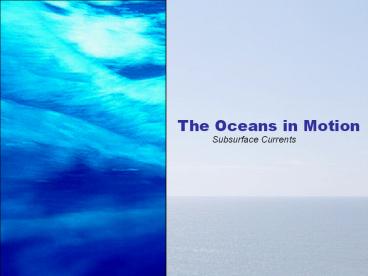Subsurface%20Currents - PowerPoint PPT Presentation
Title:
Subsurface%20Currents
Description:
Title: PowerPoint Presentation Author: A. Frankic Last modified by: anamarija frankic Created Date: 8/12/2004 12:40:56 AM Document presentation format – PowerPoint PPT presentation
Number of Views:75
Avg rating:3.0/5.0
Title: Subsurface%20Currents
1
The Oceans in Motion
Subsurface Currents
2
- Subsurface Currents
- Mechanics
- Deep water formation
- The Importance of the Global Conveyer Belt
3
Mechanics
- subsurface currents thermohaline circulation
- 90 ocean water moved by subsurface currents
- Density driven currents
- Gravity is the driving force
- Heavier, denser H2O sinks due to gravity
- density of H2O
- cold vs. warm thermo
- fresh vs. salty haline
- dense H2O sinks and less dense H2O rises
- (convection on a global scale)
- overturn and mixing of the water column, creates
an - unstable H2O column
4
Mechanics (contd)
What is a stable water column?
See Fig. 7.4 (Intro 7e) or 7.2a (Fund. 4e)
- Salinity increases with depth, temperature
decreases with depth - A stable water column is layered or stratified,
like a three layered cake
5
Mechanics (contd)
Now lets look at an unstable water column
- Salinity uniform with depth, temperature uniform
with depth - An unstable water column is not stratified, it is
well mixed - Dense water continually sinking
6
Mechanics (contd)
- Where is coldest surface water?
- at the poles
- Where is saltiest surface water?
- at the poles
- At the poles, the water column is unstable and is
well mixed because of sinking cold and salty water
NOAA
7
Deep Water Formation
Where is deep water formed?
- South Pole off coast of Antarctica
- Antarctic Bottom Water (AABW)
- 1C, 34.7 ppt
- densest water in the ocean
- North Pole off coast of Greenland
- North Atlantic Deep Water (NADW)
- 3C, 34.9 ppt
- very dense but not as dense as AABW
NADW and AABW form at surface, sink and then
spread out in horizontal direction at the bottom
of the ocean
See Fig. 7.6 (Intro 7e) or 7.5 (Fund. 4e)
8
Deep Water Formation
- NADW forms, sinks, flows southward along Atlantic
Basin, once reaches Antarctica, flows eastward
along continent, mixes with AABW, both H2O masses
flow northward into the Indian Ocean and Pacific
Oceans - These deep waters gradually warm and mix with
other waters and are upwelled in upwelling
regions (esp Equatorial upwelling zones) and flow
back toward the N. Atlantic - Starts all over again called the Great Global
Conveyor Belt - this is how H2O circulates throughout the worlds
oceans - One turn of the global conveyor belt takes
between 1000-1500yrs
Global Conveyor Belt
American Museum of Natural History
9
The Importance of the Global Conveyer Belt
Why is this important to know about?
It is a heat pump that sometime exists and
sometimes doesnt Two conditions ON or OFF
- ON
- As it is today the global conveyor belt is
turned ON - There is vigorous mixing at the poles (water
column is - unstable)
- dense surface water is sinking at the poles (very
cold - surface waters with polar ice caps)
- thermohaline circulation is initiated
- this is the switch that turns the conveyor belt
on - As the global conveyor belt returns water to the
poles (i.e. via surface - currents), the oceans give off the heat picked
up at the lower - latitudes to the land masses at the higher
latitudes (i.e. northern Europe) - oceans acting as a heat pump to warm the land
masses
10
The Importance of the Global Conveyer Belt
(contd)
- OFF
- As it has been in the past- the global conveyor
belt is turned OFF - There is no vigorous mixing at the poles (water
column is stable) - there is no dense water sinking at the poles
- (surface waters warmed, polar ice caps melt)
- thermohaline circulation is not initiated
- the global conveyor belt switch is turned off
- There is no heat pump to warm the land masses
- much colder in northern Europe
11
The Importance of the Global Conveyer Belt
(contd)
Example of when the global conveyor belt has been
turned off
- Younger Dryas-discovered about 20 years ago
- right now were in an ice age- we have been for
the past 2 million years - last glacial stage ended 11,000 ybp
- after last glacial stage ended there was a 2000
year warming period - interrupted by a 700 year return to glacial
stage conditions - how do we know? pollen records
- forests grew for 2000 years, abruptly stopped (no
pollen records) - and then resumed growing about 700 years later
(pollen records again) - cold snap period known as the Younger Dryas
12
The Importance of the Global Conveyer Belt
(contd)
- What do we think happened to cause the Younger
Dryas? - As earth warmed during warming 2000 year warming
period - the surface waters also warmed
- polar ice caps melted (surface waters less salty)
- northern Atlantic surface water less dense
- no vigorous mixing, interruption in thermohaline
circulation - global conveyor belt turned off
- no heat transfer to northern Europe
- ice sheets, no forests grow
- Another example of when the global conveyor belt
is turned off - We also have records of a prolonged period of
cold in northern - Europe from 1650-1850
- known as the Little Ice Age
- could have been caused by an interruption or
slow-down in - thermohaline circulation, conveyor belt slowed
down (sluggish)































